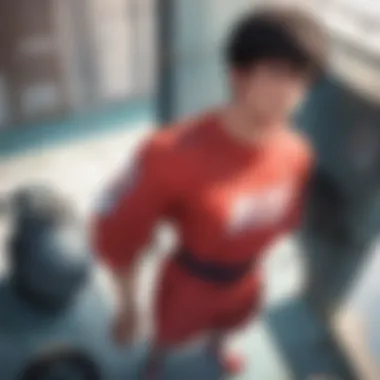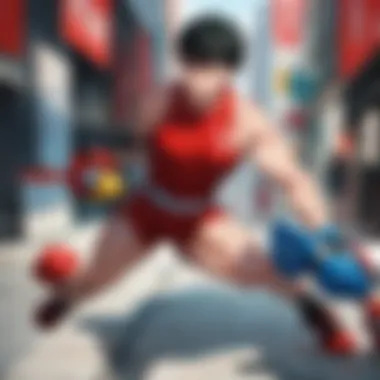An In-Depth Exploration of Hajime no Ippo


Intro
Hajime no Ippo has established itself as a monumental force in the realm of boxing anime. It not only tells an engaging story but also provides insight into the intricacies of the sport. The series, which spans over two decades, captivates its audience through a mix of drama, humor, and compelling fight sequences.
This article takes an in-depth look at various aspects of Hajime no Ippo, from the narrative structure to character development and the cultural significance that underpins it.
Featured Series or Manga
Overview of the Series
Hajime no Ippo first appeared as a manga in 1989. Created by George Morikawa, it follows the journey of Ippo Makunouchi, a high school student who discovers boxing while defending himself from bullies. The series chronicles Ippo's rise in the boxing world, showcasing intense training, memorable matches, and the struggles he faces both in and out of the ring.
The anime adaptation aired in 2000 and quickly garnered a significant fanbase due to its engaging storytelling and dynamic animation. As a result, it expanded into several seasons, OVA episodes, and also included numerous adaptations of the manga story arcs.
Key Characters and Development
The cast of Hajime no Ippo is rich with diverse and well-developed characters.
- Ippo Makunouchi is the protagonist, showcasing the journey from a timid boy to a confident boxer. His growth is central to the narrative, with each fight acting as a stepping stone.
- Mamoru Takamura, an experienced and brash boxer, serves as Ippo's mentor. His larger-than-life personality often lightens serious moments while emphasizing the mentor-student relationship.
- Other characters such as Eiji Date and Ryo Mashiba also contribute significantly to the narrative, providing unique challenges and rivalries that further develop Ippo’s character.
Character Analysis
Major Characters
Each character in Hajime no Ippo has a distinctive role that shapes the narrative.
- Ippo embodies perseverance, hard work, and personal growth. The stakes become higher as he confronts his fears and insecurities through battles.
- Takamura represents the high-pressure environment of professional sports. His backstory adds depth and shows the sacrifices necessary to succeed.
- Supporting characters like Aoki and Kimura provide comic relief but also have their arcs that reflect the struggles of aspiring boxers.
Character Arcs and Growth
"In Hajime no Ippo, every character has a story that inspires and motivates ultimate growth."
The character arcs are fundamental to the series. Ippo begins as one needing validation, focused more on gaining respect rather than fame. As he continues to train, he becomes more confident in his abilities.
Takamura, while serving as a mentor, faces his own challenges. His journey intertwines with Ippo's, amplifying the theme of mentorship and friendship in the face of adversity. Supporting characters also experience personal growth, some revealing their motivations and fears, making the world of Hajime no Ippo more relatable.
Thematic Exploration
Main Themes and Messages
Throughout the series, several themes emerge prominently:
- Perseverance stands out, as Ippo's journey is filled with setbacks yet marked by relentless determination.
- Friendship is illustrated as pivotal, with relationships among boxers emphasizing support during rivalry.
- The theme of self-discovery resonates, particularly as Ippo learns about himself amid challenges, evolving as a boxer and an individual.
Cultural Context and Influences
Hajime no Ippo reflects Japan’s cultural landscape, demonstrating the reverence for martial arts. Its detailed portrayal of boxing receives attention, respecting the sportability while making it accessible and relatable through Ippo’s story.
The series not only entertains but also inspires, bridging the gap between personal ambition and cultural identity within the world of anime.
Prelude to Hajime no Ippo


The initial section serves as a gateway into the world of Hajime no Ippo. Understanding the premise of the series and its historical roots offers vital context for its significance in the realm of boxing anime. By examining both the overview of the series and its context within the broader anime landscape, readers can appreciate the nuances that make Hajime no Ippo a hallmark of this genre. This framework allows for a deeper exploration of its narrative and thematic depth in the sections that follow.
Overview of the Series
Hajime no Ippo, created by George Morikawa, began serialization in 1989. It follows the journey of Ippo Makunouchi, a timid high school student who aspires to become a professional boxer. Initially, Ippo is bullied and holds a low self-esteem, but boxing transforms him. The story unfolds through Ippo’s training, fights, and personal growth as he strives to win titles.
The anime adaptation first aired in 2000, bringing the manga's engaging narrative to life. With over a hundred episodes, it showcases Ippo’s development alongside numerous characters, each with their own storylines. The series artfully blends comedy, drama, and intense boxing action, appealing to a wide audience.
The importance of Ippo's journey lies not only in his pursuit of victory but also in how boxing symbolizes personal growth and resilience. This narrative thread resonates deeply within fans, illustrating the struggle to overcome life's challenges through diligence and bravery.
Historical Context of Boxing in Anime
Boxing has long been a popular theme in anime. Before Hajime no Ippo's debut, series such as Ashita no Joe set a precedent by incorporating the sport's matches and the protagonist's struggles with its complexities. These stories often reflect broader themes of dreams and the fight to achieve them.
Hajime no Ippo came at a time when the anime industry was expanding. It introduced a fresh take on boxing by combining humor with serious training montages and compelling character dynamics. As the boxing genre evolved, Hajime no Ippo carved its space, becoming a template for future works, influencing both creators and audiences. It highlights the sport’s physicality while simultaneously exploring character motivations, revealing deeper emotional layers behind the matches.
Through Ippo’s growth and rivalries, the series encapsulates the ongoing struggle faced by many, which resonates well with viewers, fostering a connection that transcends the medium of anime itself. This historical significance enhances the understanding of Hajime no Ippo within the anime landscape, solidifying its status as a cornerstone of boxing narratives.
Narrative Structure
The narrative structure plays a pivotal role in the success of Hajime no Ippo, defining how the story unfolds and how the characters evolve through their journeys. Understanding the narrative elements allows viewers and readers to appreciate the intricate storytelling techniques that elevate the series beyond mere entertainment. The manner in which plot points are laid out and conflicts arise directly influences audience engagement and emotional investment.
Plot Development
Hajime no Ippo utilizes a linear plot structure complemented by various subplots that intertwine with the protagonist's growth. The main narrative follows Ippo Makunouchi as he moves from being a timid and introverted high school student to a formidable boxer. This progression is important as it mirrors the challenges many face in their own lives, making the story relatable.
The plot is rich with training montages, bouts, and personal conflicts, demonstrating the balance between physical and emotional development. Various turning points, such as Ippo's encounters with seasoned boxers, provide critical moments that help shape his character and reinforce the series' themes of perseverance and resilience. Major arcs focuss on tournaments and rivalries, maintaining a steady rhythm that keeps audiences invested.
Conflict and Resolution
Conflict in Hajime no Ippo arises from different sources: internal struggles within Ippo, competing against other boxers, and personal relationships. This multi-layered conflict enriches the narrative, allowing for deep character interactions. Ippo's main conflict stems from his self-doubt, constantly challenged by opponents that push him to his limits. Each match presents not only a physical battle but also a psychological one, showcasing his growth as a boxer and an individual.
Resolution comes not only at the end of arcs but also throughout the series, as characters face their own demons. By overcoming various challenges, Ippo learns the true meaning of friendship and rivals who test his abilities. Each resolved conflict builds towards greater stakes in subsequent fights, exhibiting the importance of growth and development. As the series progresses, the resolution of conflicts showcases how far Ippo has come, not just as a boxer, but as a determined person ready to pursue his dreams.
"The depth of conflict and the complexity of resolutions in Hajime no Ippo reflect the nuances of human resilience. They inspire audiences to confront their own challenges."
Character Analysis
The analysis of characters is essential in understanding the depth of Hajime no Ippo. Characters drive the plot, showcase the themes, and embody the series’ emotional resonance. Each character is carefully crafted, ensuring that they are not merely placeholders but rather essential components that contribute significantly to the narrative.
Protagonist: Ippo Makunouchi
Ippo Makunouchi stands at the center of this narrative. His journey from a timid and bullied youth into a determined boxer represents personal growth and the struggle against adversity. Ippo’s character is relatable; he faces challenges that many viewers understand in their life.
His development is not just in his boxing skills but also in his ability to maintain friendships and confront his fears. This complexity makes Ippo a compelling protagonist. The audience roots for him not just because he trains hard, but because he embodies the essence of perseverance.
His most significant characteristics include
- Determination: Ippo’s commitment to improve himself is inspiring.
- Kindness: He often shows empathy and respect to others, reflecting his good nature.
- Growth: Each fight teaches him a valuable lesson, contributing to his transformation.
Supporting Characters
Supporting characters are crucial in creating a rich world around Ippo. They offer contrasts, friendships, and rivalries that propel the story. Characters like Takahashi, Aoki, and Kamogawa add depth to the narrative. They help build the boxing community in the series and showcase different aspects of Ippo's character.


These characters often deal with their struggles, making the themes of friendship and rivalry more impactful. For instance, Aoki’s initial jealousy of Ippo’s talent creates a competitive bond that evolves into mutual respect.
Antagonists and Rivals
The series excels at presenting nuanced antagonists and rivals. Characters like Takamura and Miyata not only challenge Ippo physically but also mentally. They represent different pathways and motivations within the sport of boxing. Takamura, for instance, embodies confidence and arrogance while training Ippo, serving as a mentor figure despite his tough nature.
Miyata, on the other hand, symbolizes Ippo’s personal growth. Their rivalry pushes both characters toward excellence, showcasing how competition can lead to improvement. Moreover, this dynamic creates a tension that keeps viewers engaged.
In summary, character analysis in Hajime no Ippo reveals how integral personal journeys and relationships are to the narrative. The protagonist’s growth, supported by a cast of rich characters, illustrates the importance of determination, friendship, and rivalry in the world of boxing.
Thematic Exploration
Exploring the themes within Hajime no Ippo enhances understanding of its core concepts. The series resonates with audiences on multiple levels, engaging them in more than just boxing. It touches on universal concepts such as hardship, camaraderie, and the relentless chase for aspirations. This thematic richness is crucial in distinguishing Hajime no Ippo within the anime landscape.
Overcoming Adversity
One of the central themes is overcoming adversity. Ippo's journey began in a place filled with self-doubt. His character starts as a timid boy bullied by others. The evolution of Ippo's character arcs represents the journey many endure in their pursuit of self-worth. Through rigorous training and determination, he faces not only physical opponents but also his internal struggles. This theme serves to inspire viewers, showcasing that strength can come from vulnerability. In essence, the battles inside the ring are often reflections of the conflicts we face in our daily lives.
Friendship and Rivalry
The theme of friendship and rivalry is intricate in Hajime no Ippo. The relationships between characters play a vital role in shaping their development. Boxers like Takamura and Maeda are more than just allies; they serve as mirrors through which Ippo sees his challenges. Rivalries in boxing often lead to personal growth. For example, the rivalry between Ippo and Miyata ignites a competitive spirit that pushes both characters to excel. Through this lens, Hajime no Ippo illustrates how both friendship and conflict are necessary for growth in sports and life.
Pursuit of Dreams
The pursuit of dreams is a recurring motif that underscores the narrative. Ippo's goal is to become a champion, and this aspiration drives the storyline forward. The series delves into what it means to chase dreams against the odds. Each bout represents not just a fight for titles but a step closer to personal fulfillment. The theme resonates with audiences who may find themselves struggling for their own aspirations. It highlights a path filled with obstacles but ultimately emphasizes the value of persistence and hard work.
"The true measure of a fighter is not how many wins they have, but how they rise after the fall."
Artistic Style
The artistic style of Hajime no Ippo plays a crucial role in defining its identity and effectiveness as a boxing anime. The visual elements are not merely aesthetic choices; they serve to enhance the narrative, evoke emotions, and immerse the audience in the sport of boxing. This section explores notable components of the artistic presentation and the considerable impacts they have on storytelling and audience engagement.
Animation Techniques
The animation techniques utilized in Hajime no Ippo reflect a high level of craftsmanship and artistry. The fluidity of motion during the boxing matches stands out, allowing viewers to appreciate the intensity of each fight. Animators employ a combination of traditional hand-drawn methods along with some digital enhancements. This hybrid approach brings a unique texture to the scenes.
One specific technique is the use of speed lines and exaggerated impacts during punches, which heighten the drama of critical moments. When a fighter lands a crucial blow, these effects visually amplify the force and gravity of the strike, making each bout memorable. Furthermore, the pacing in animation mirrors the rhythm of real boxing matches. Quick cuts and close-ups capture the athletes’ expressions and physical prowess, ensuring viewers remain engaged and invested in the action.
Character Design
Character design is central to how audiences perceive the fighters in Hajime no Ippo. Each character exhibits unique physical traits and styles that reflect their personalities and boxing techniques. For instance, Ippo Makunouchi's stocky build signifies his strength while embodying the underdog archetype, contrasting with the leaner, more agile designs of his rivals.
Moreover, the attention to detail continues beyond just physical appearances. Each character's attire is carefully crafted to reflect their individual backgrounds and boxing styles. For example, characters from different gyms wear distinct uniforms that showcase their training affiliations. This design choice also serves as an indicator of their development throughout the series, as they might display different gear or modifications during key matches. \n
Impact of Visuals on Storytelling
The visuals in Hajime no Ippo extend beyond mere animation and character design; they significantly enhance storytelling. The artistic elements contribute to the atmosphere of the series, creating a sense of realism that allows the audience to feel the stakes of each fight.
For instance, lighting techniques can evoke different moods. A well-lit training montage might inspire determination, while shadowy scenes in critical matches could reflect doubt or high tension. Character expressions painted with varying degrees of detail capture emotional highs and lows succinctly, making the viewers empathize with their struggles.
"Visual storytelling in anime like Hajime no Ippo becomes an integral part of the narrative framework, amplifying emotional connectivity and engagement between the viewer and the narrative."


The combination of these elements creates a narrative that is rich and immersive. Overall, the artistic style in Hajime no Ippo serves not just as a backdrop, but as an essential element that adds depth to the series, aligning perfectly with its exploration of boxing and personal growth.
Cultural Impact
The influence of Hajime no Ippo extends beyond its narrative and animation. The series has carved a significant niche in both Japanese culture and the global anime community. It reflects not only the sport of boxing but also broader themes such as determination, perseverance, and personal growth. Digital platforms and social media channels help amplify this influence, making it a topic of discussion in various forums. The anime has created a fanbase that transcends age and geography, showcasing the universal appeal of its core messages.
Reception in Japan
In Japan, Hajime no Ippo has been met with critical acclaim since its debut. The series resonated well with audiences, blending humor, drama, and sports action in a balanced manner. Notable is its ability to reflect the values of Japanese society, particularly the emphasis on hard work and resilience. This cultural framework has made the show relatable, and many viewers find themselves identifying with Ippo’s struggles and triumphs. The manga's serialization in Weekly Shōnen Jump introduced it to a broader audience, contributing to its status as a classic. Its ongoing popularity is evident in merchandise sales and themed events, indicating its deep entrenchment in the fabric of Japanese entertainment.
Influence on Western Audiences
While Hajime no Ippo has a solid foundation in Japan, its impact on Western audiences cannot be overlooked. The series has been praised for its realistic portrayal of boxing, setting it apart from more fantastical anime. Fans appreciate the depth of character development and the authenticity of boxing techniques presented in the show. Streaming platforms like Crunchyroll and Funimation have facilitated its accessibility, further fueling interest outside Japan. Discussions on platforms like Reddit reveal a growing community that appreciates the show's blend of sports action and deep character arcs. This recognition has laid groundwork for subsequent boxing-themed anime, influencing storytelling approaches in the genre.
Legacy of the Series
The lasting legacy of Hajime no Ippo is notable. It has paved the way for future sports anime through its unique storytelling techniques and character portrayals. The phrase "boxing anime" often evokes immediate associations with Ippo's journey, establishing a benchmark for other series to aspire to. The influence is evident in newer works, which draw inspiration from its themes and narrative structure. Moreover, the series has maintained a consistent quality throughout its decades-long run, ensuring its relevance in both current and future discussions about sports anime.
"Hajime no Ippo isn't just a sports anime; it serves as a guide to overcoming life’s challenges through the lens of boxing."
Adapting the Manga
Adapting the manga of Hajime no Ippo into anime was a significant endeavor that bridged the gap between two distinct mediums. The manga, created by George Morikawa, offers a detailed narrative combined with unique stylistic choices. When adapting it for anime, producers faced the challenge of preserving the essence of the original while making it approachable to a broader audience. The anime adaptation introduced the characters and their journeys through dynamic visuals and voice-acting, increasing engagement and reaching fans beyond those who read the manga.
The adaptation also brought new elements to the storytelling process. With animation, physical expressions, movements, and the intensity of boxing matches could be vividly portrayed, enhancing viewers’ emotional connection to the characters. The music score further amplified crucial moments, enriching the overall experience. However, adaptation is not without challenges. The pacing of the original manga is sometimes altered in the anime to fit episode formats, which can lead to a different narrative flow.
Comparison Between Manga and Anime
When comparing Hajime no Ippo’s manga and its anime adaptation, various aspects warrant attention. The manga spans many chapters, allowing for deeper character development and more complex arcs. Readers are often treated to detailed internal dialogues that animate the subtle nuances of Ippo’s thoughts and feelings.
On the other hand, the anime focuses on key moments, employing visuals to quickly drive its narrative. While this can bring an exciting energy to the matches, it risks oversimplifying storylines that are richer in the manga.
- Visual Mediums: The manga provides still images, relying on artistry and pacing to convey emotions, whereas the anime uses movement and music, offering a different type of engagement.
- Character Moments: In the manga, minor characters may receive more backstory, which might be condensed or omitted in the anime for pacing.
- Artistic Choices: The manga delivers a more uniform style throughout its pages, while the anime sometimes adapts to new artistic techniques, impacting character appearances during intense scenes.
Key Differences in Storytelling
Storytelling in Hajime no Ippo varies notably between its manga and anime forms. In the manga, George Morikawa integrates lengthy arcs that provide comprehensive backgrounds of supporting characters. Conversely, the anime adaptation tends to streamline these arcs, often focusing more on Ippo’s journey rather than exploring the backstories of his counterparts.
The pacing disparities create a different feel:
- Character Depth: Manga allows for slow-burn character development that fosters attachment, while anime can rush through character introductions, impacting viewer empathy.
- Match Sequences: Manga’s match sequences may include strategic thinking and character reflections during bouts. The anime may focus more on action sequences to maintain visual excitement, sometimes losing the strategic depth.
- Theme Exploration: Some themes in the manga, such as the psychological aspects of boxing, may be more elaborately discussed compared to the quicker pacing of the anime, which leans more toward visual impact.
"The adaptation process is critical; it can define how fans perceive the core emotions and motivations of characters, impacting their connection with the series."
Overall, while the anime adaptation of Hajime no Ippo successfully brings the story to life visually, readers of the manga are treated to a richer narrative texture that explores the characters and their journeys more thoroughly.
The End
The conclusion serves as an essential component of any analysis, synthesizing the insights gleaned from earlier sections. In the case of this article, it encapsulates the multifaceted nature of Hajime no Ippo. By understanding the series' influence and appeal, readers can appreciate its significance in the boxing genre of anime.
Final Thoughts on Hajime no Ippo
Hajime no Ippo stands as a testament to the power of storytelling within anime. The series is not simply about boxing; it represents the struggles, triumphs, and growth of its characters. Ippo Makunouchi's journey mirrors the broader theme of personal growth and relentless pursuit of dreams.
The careful development of antagonists and supporting characters adds depth to the narrative, creating a rich tapestry of interactions that engage viewers. Furthermore, the distinct artistic style contributes significantly to storytelling, making emotional moments resonate deeply.
"Hajime no Ippo connects with audiences on multiple levels: passion for sports, the importance of friendships, and the quest for self-discovery."
The cultural impact of Hajime no Ippo extends beyond Japan, influencing boxing narratives in Western media. It is a series that continues to set standards within the genre, showcasing that even animated tales of boxing can deliver profound life lessons. The exploration of its themes, character arcs, and dedication to the sport is remarkable and worthy of appreciation.



